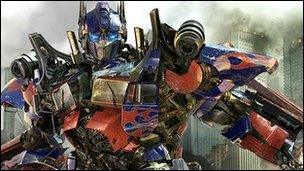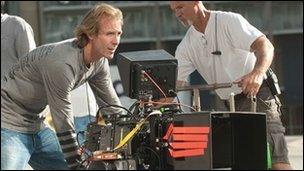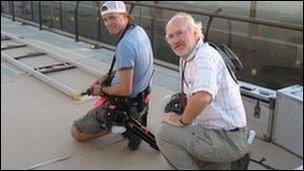The SFX wizard who sparked the Transformers into life
- Published
Oscar-winning special effects supervisor Scott Farrar on his art form
A giant metallic worm-like creature wraps its tentacles around a Chicago skyscraper, punching out windows like a pneumatic drill.
As it twists its way up the building, two humans cower inside, but start to slide helplessly as the structure snaps in half.
Objects fly across view as an army of remorseless robots bear down on our hero, intent on destruction.
It is scenes such as these in Transformers 3 that make Scott Farrar chuckle like a child and conclude, "wow, that really is cool".
And it is this hyper-real movie magic that has made the Oscar-winner one of the most sought after visual effects supervisors in Hollywood.
Credits in his CV include Return of the Jedi, Back to the Future 2 and 3, Cocoon, Jurassic Park, Minority Report and The Chronicles of Narnia.
Just ahead of the DVD release of Transformers 3: Dark of the Moon, he took time out to discuss his craft and how it continues to shape Hollywood.

Transformers 3 has grossed more than $1bn (£650m) worldwide
<bold>Transformers 3</bold>
"I'm really proud that people get puzzled by what they are looking at," says Scott Farrar with a grin.
"They are confounded, they think it must be a puppet because CGI [computer-generated imagery] always looks fake."
The latest Transformers film is his third collaboration with director Michael Bay. Once again it offers a tour de force of special effects, even if the critics were less kind about the movie's storyline.
The franchise, based on the hugely popular 1980s children's Transformer Toys, has become synonymous with the quest for ever more jaw-dropping images.
But it is not only Transformers 3's show-stopping moments that Mr Farrar is proud of and eager to talk about.
He also highlights the robots' ability to display feelings, which he believes has evolved as the series progressed.
"We've got better at nuance and emotion, and learned that animated characters have to act too," says Mr Farrar.
"We don't use motion capture a lot any more, putting tracking markers on the face."
The trick to helping characters like Optimus Prime and Bumblebee seem alive is, in fact, to add more graphics.
"We found that by adding more metal around the mouth, we could display emotion."
Mr Farrar says he thinks of his robot characters as "silent movie actors, like Charlie Chaplin types".

Scott Farrar says Michael Bay (left) has become more comfortable with computer graphics
He knows he has a successful scene in the can when he feels himself empathise with one of his creations during the film's quieter moments - however many times he has seen the footage.
<bold>Trust</bold>
The Transformers films also bear witness to director Michael Bay's conversion to the power of the computer animation technology offered by Mr Farrar's team.
"Michael didn't trust computer graphics very much when I first met him," says Mr Farrar.
"He always wanted to shoot everything as real as possible, including as many miniatures as possible."
"He now realises what the technology can do for him, and for the narrative of the film."
The director gained so much confidence in his special effects team that he let them pitch ideas, and the best were "plugged into the movie", Mr Farrar says.
<bold>Evolving role</bold>
Like many film-makers of his generation, Mr Farrar's creative journey began with the humble Kodak Brownie camera.
"I begged my parents to use the Brownie wind-up, to shoot vacation photos, and make models in the backyard," he says.
"You experiment, and nobody is telling you what to do."
Mr Farrar was able to practice basic stop motion techniques as well as practising stunt scenes with friends.
Over the years since turning his hobby into a career, Mr Farrar has noticed the role of visual effects supervisor has gained prestige, changing the dynamic with the director.
"There used to be a time when you would slink in and slink out."
"You would do your bit and not intrude with the rest of the show because you only had 20 shots in the movie."
"Now you have hundreds or thousands of shots in the movie."
As special effects advance there is a risk that they can end up dominating a film at the cost of its narrative.
But Mr Farrar says that his craft cannot be blamed.
"It's like in the Renaissance, people all had brushes and paint and canvases, but there were some that really figured it out, really practised and learned to look at the world and bring dark and light onto the canvas."
"So it's your perception - not just the tools".
<bold>Another dimension</bold>
Transformers 3 is in effect "3D-ready".
A three-dimensional version of the film was recorded alongside the traditional footage, and will be released in 2012.
While filming parallel versions may be becoming more common, there is still debate about whether older films should be altered - including Star Wars.
Scott Farrar is a living link between George Lucas's Star Wars' prequels and sequels.
He worked on the effects for both Return of the Jedi, and the first prequel, The Phantom Menace.
When asked if he minds that his work on the Star Wars films is being tweaked for the 3D re-releases, Mr Farrar's answer is direct and simple.

Scott Farrar (right) prepares a shot on the latest Transformers film
"Why not?"
He says he believes 3D "really works on certain films", depending on how the director shot them.
And the "incredible depth" which Mr Lucas built into his shots, allowing the audience to "feel the depth", makes them ideal for the treatment.
Mr Farrar recalls seeing a 3D "test" version of the first Star Wars film.
"When the destroyer comes in, it was great," he says.
New techniques for transferring old stock to 3D makes the transition more compelling, he argues.
"You are no longer talking about 3D that is projected onto film," Mr Farrar says.
"It was somewhat disconcerting to see film in 3D where it bounced around the gate all the time. It was fatiguing frankly.
"Now if you have a digital projector, you can take an old film and you can steady it. And you can now project it so it is rock steady. It really works on certain films."
In the freedom of childhood with his budget equipment, Mr Farrar gained a quality that remains on display.
"I learned the excitement," he declares with passion.
"You're always using film tricks when you are using a camera, and doing visual effects is just expanding your bag of tricks."
From his backyard to cinemas worldwide, Mr Farrar's tricks are now beguiling millions.
- Published14 May 2011
- Published1 February 2011
- Published28 June 2010